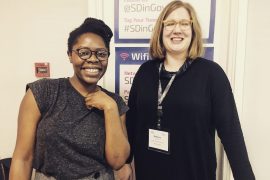I’m at the conference Service Design for Government in London (that’s why this blog is in English). The coming days are packed with great talks and workshops, and meeting all kinds of new people working in design for government in all of Europe. I am going to blog about this experience in the coming days. Here goes…
As a designer you often have to lead a meeting, a project, a team or even your organization in the service design process. These two ladies, Rebecca Kemp and Ade Adewunmi shared their tips and what-not-to-do’s in a fun and very recognizable talk. In this blog I will tell you the 5 essentials of leadership in service design (and tell you how I failed all 5).
First of all, make sure you have a good story.
Make it stick, make it real. And make it concrete. Don’t just say: “I want to do a new service because I like a new service.” Rebecca gave us a format in which you can make your story:
We aim to [do thing]. A new/ improved service will help to do that by [doing part of the new thing]. It will cost [this much] and will bring in [more than that]. Please can you [take this action] so we can make it happen?
As a user researcher myself I love to talk about users, what they think and what they feel. I love to explain the vision I have for how we can meet all these user needs, but as I am not the most organized person I often lack the (structured) evidence to back up what I’m saying. I can be very enthusiastic and with that very persuasive, but in the end I cannot deliver. Leads me to the next…
Have the evidence of putting users first
So make sure you not only have a good story, but also the evidence of putting users first. A few weeks ago I was on location doing a usability test with a livestream and collegeas at the office could tune in. One of my team members had to do a presentation on service design and ‘why ya need it’. He then realized that we have a live test going on and he just showed the livestream. They watched ’the evidence’ for several minutes and after a while the team said: “we want it too, where do we get it?” Seeing the evidence is so much more powerful then telling about it.
Get people involved, it gets them excited
You are not alone in this, user research is a team sport. “We aim to…” This ‘we’ is not we, the design team, but we the organization. You are always part of a bigger team. Involve them in the project. But also: make it easy for them to be involved. Nobody wants to see a video of 30 minutes or longer. Make the research and the insights accessible and fun for everyone within your organization.
Don’t be mean
OMG, don’t be mean. This is such a good one. It’s so much easier though if people like you. Or at least don’t hate you. Don’t say: everything that exist is rubbish, my answer will solve everything. It probably won’t and you will not be consistent anymore. But also: people did their best, so don’t be a bitch about it. Don’t go down in flames for your pure love for the project and offend everyone along the way (down).
Rebecca gave an example from
the movie Up in the air. A lot of times designers can seem the one that have to tell others they won’t have a job anymore. I remember myself in a particular conference room telling a bunch of people on the other side of the table with all the worlds enthusiasm
“Hey, let’s automize this in that way for the users, than you guys don’t have to do that anymore.” And that was their job. No surprise I’m no longer on that project. So remember… sometimes you may appear as George Clooney.
Look after yourself
As a user research one of my strong points is that I have empathy and that I can relate to people in an emotional way. And exactly this emotional approach can make me a roaring lion that goes up in flames when I’m met with less empathy for my (users) case. I can imagine myself banging my head to a wall or better: banging heads of colleagues together. I might even have said in frustration during a meeting with someone who kept interupting me: “If you touch my laptop one more time, I’m gonna have to pound on you just a little bit.” The meeting didn’t go so well after that. So Rebecca and Ade asked: “what can you do to look after yourself?” How can you stay focused, stay motivated and keep loving what you do as a designer?

